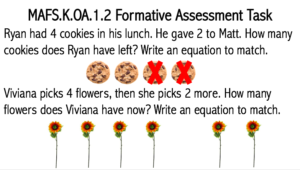MAFS.K.OA.1.2: Solve addition and subtraction word problems1, and add and subtract within 10, e.g., by using objects or drawings to represent the problem (1Students are not required to independently read the word problems.)
Cognitive Complexity Level: 1-Recall
[divider] [/divider] Students are able to…
- Add and subtract within 10
- Represent problems with concrete objects and move to pictorial representations
[divider] [/divider] Students are able to…because teachers:
- Provide multiple experiences with each problem-solving situation including add to, take from, put together, separate, take apart, etc.
- Make connections to prior addition and subtraction learning
- Focus on actions of problems, rather than key or clue words
[divider] [/divider] Questions to ask students:
- What is the action in the problem?
- Sample answer that indicates understanding: putting together, joining, adding to, taking from, separating, etc.
- How do you know you are putting together, joining, or adding to?
- Sample answer that indicates understanding: Students are able to correctly identify the action in the problem. Consider the problem, “There are 2 students at the water fountain. Two more get in line. How many students are in the water fountain?” Student should be able to identify the action is adding to.
- How do you know you are taking from or separating?
- Sample answer that indicates understanding: Students are able to correctly identify the action in the problem. Consider the problem, “Joseph is holding 4 crayons. Miracle takes one. How many crayons does Joseph have now?” Student should be able to identify the action is taking from.
[divider] [/divider] Additional Resources:
Additional in depth content knowledge
Blog Post:
Joining and separating… using actions to understand addition and subtraction
Video:
ORIGO: Exploring add-to addition
ORIGO: Introducing types of subtraction
[divider] [/divider] Sample Formative Assessment Tasks:
[divider] [/divider] Resources/Tasks to Support Your Child at Home:
Use household situations to create word problems and have your child solve them. For example, you may pose a problem similar to: Mom had 2 cans of beans on the top shelf and 3 cans of beans on the bottom shelf. How many cans of beans are in the pantry?
http://goo.gl/xksa1n This interactive site allows students to practice addition and subtraction.
